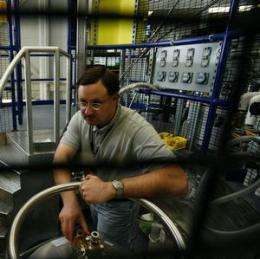To get a better understanding of these silver compound ionic liquids, Eugene Mamontov, lead instrument scientist on BASIS, the Backscattering Spectrometer at ORNL’s Spallation Neutron Source, used quasielastic neutron scattering to probe the diffusion dynamics at the microscale that characterize these new solvents. Photo by Charlie Brooks
(PhysOrg.com) -- The separation of olefins and paraffin, two hydrocarbon compounds in petroleum waste streams, is a heavy expense for the petrochemical industry. The existing technology consumes a lot of energy because the olefin-paraffin pairs have similar boiling and evaporation properties, making it difficult and costly to separate them. Companies are looking for techniques that reduce energy consumption and that economically recycle such waste streams.
New research at Oak Ridge National Laboratory shows that olefins can be separated from paraffin efficiently and economically using silver complex-based ionic liquids. Room temperature ionic liquids are a promising class of novel materials—salts that are molten at or near room temperature. They are made up of ions rather than molecules. Ionic liquids do not easily evaporate, making them potentially recyclable and environmentally friendly solvents.
There are more than 400 ionic liquids that have been commercialized. The wide variety of materials that can be used to make them enables scientists to choose the ones best suited for a research project. These materials have a wide range of potential applications in the chemical industry, including in the separation of petroleum by-products in the oil industry.
This work builds on recent investigations into a membrane technology that makes it easier to transport olefins out of a waste stream. In this hybrid olefin-paraffin separation method, silver or copper ions are used to bind to olefin to form an ionic liquid. The silver or copper ions then act as carriers for the unwanted and transfer them through the membranes. Two of this new class of silver compound ionic liquids are currently under study.
To get a better understanding of these silver compound ionic liquids, scientists used quasielastic neutron scattering, or QENS, on BASIS, the Backscattering Spectrometer at ORNL's Spallation Neutron Source. QENS can probe the diffusion dynamics at the microscale that characterize these new solvents. Subsequent analysis of the scattering data points to three distinct components in the mechanism that transports the olefins.
The room-temperature ionic liquids for separating petroleum by-products have low vapor pressure (they evaporate only at very high temperatures), high thermal stability, and both positive and negative ions move freely through them. The researchers investigated the usefulness of these metal bearing solvents for the extraction and membrane separation of inorganic, organic, and gaseous species; for sensing volatile organic vapors; and for synthesizing novel materials.
A key feature of these new solvents is that the silver ions are incorporated as integral components of the ionic liquid at the molecular level. They are very stable and the silver content is several orders of magnitude higher than that of conventional liquid- or polymer-supported membranes, which makes it easier to drive the olefins through the membrane. In the current work, QENS neutron scattering provides fundamental insight into the olefin transport that cannot be obtained through other characterization techniques.
The QENS analysis shows that in the temperature range of 300 to 340 K, three dynamic components are present in the silver compound ionic liquid solvents and can be described in the microscopic transport on the pico- to nanosecond timescale. These occur in both the new solvents. The findings are similar to those found in a study of an ionic liquid developed earlier. This suggests that the three dynamic components found by neutron scattering may be a common feature of the ionic liquids' microscopic dynamics and are likely related to a fundamental lack of order in these materials at the nanoscale.
Provided by Oak Ridge National Laboratory



















